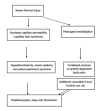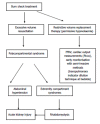Rhabdomyolysis, compartment syndrome and thermal injury
- PMID: 24834396
- PMCID: PMC4021149
- DOI: 10.5492/wjccm.v3.i1.1
Rhabdomyolysis, compartment syndrome and thermal injury
Abstract
Rhabdomyolysis (RML) after electrical burns and crush injuries is a well-known clinical entity, but its occurrence following thermal injury has not gained so much attention. Capillary leak syndrome and following polycompartmental syndrome are devastating end results of major thermal injuries. In the current review, polycompartment syndrome within the clinical picture of systemic oedema and its relationship to RML is discussed along with its management and prevention.
Keywords: Capillary leak syndrome; Rhabdomyolysis; Thermal injury.
Figures





References
-
- Better OS, Stein JH. Early management of shock and prophylaxis of acute renal failure in traumatic rhabdomyolysis. N Engl J Med. 1990;322:825–829. - PubMed
-
- Wiedemann HP, Wheeler AP, Bernard GR, Thompson BT, Hayden D, deBoisblanc B, Connors AF, Hite RD, Harabin AL. Comparison of two fluid-management strategies in acute lung injury. N Engl J Med. 2006;354:2564–2575. - PubMed
-
- Heymsfield SB, McManus C, Stevens V, Smith J. Muscle mass: reliable indicator of protein-energy malnutrition severity and outcome. Am J Clin Nutr. 1982;35:1192–1199. - PubMed
-
- Gallagher D, Heymsfield SB. Muscle distribution: variations with body weight, gender, and age. Appl Radiat Isot. 1998;49:733–734. - PubMed
-
- Janssen I, Heymsfield SB, Wang ZM, Ross R. Skeletal muscle mass and distribution in 468 men and women aged 18-88 yr. J Appl Physiol (1985) 2000;89:81–88. - PubMed
LinkOut - more resources
Full Text Sources

